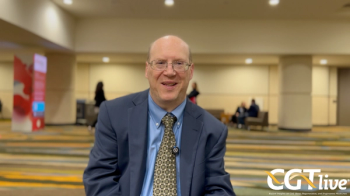
REGENXBIO’s Gene Therapy Improves Diabetic Retinopathy Disease Severity
Updated data from the ALTITUDE trial were presented at the 55th ARS meeting in Pasadena, CA.
The
Data from the study were presented by Lejla Vajzovic, MD, FASRS, assistant professor of ophthalmology, adult and pediatric vitreoretinal surgery and diseases, Duke University Eye Center, at the 55th Annual Retina Society (ARS) meeting in Pasadena, California.
"We are pleased with these positive interim results which demonstrate a clinically meaningful improvement in disease severity versus observational control, with more than 50% of patients dosed with RGX-314 in Cohorts 1-3 seeing improvement from baseline in their DRSS scores," Steve Pakola, MD, chief medical officer, REGENXBIO, said in a statement.2 "RGX-314 continues to be well-tolerated across cohorts, and we look forward to the expansion of this trial to further evaluate the potential of RGX-314 for patients with DR."
The open-label, randomized, controlled, multicenter, dose-escalation ALTITUDE trial is evaluating the safety, tolerability, and efficacy of RGX-314 in patients with moderately severe to severe nonproliferative DR (NPDR) or mild proliferative DR (PDR).1 The therapy is delivered via suprachoroidal injection using the SCS Microinjector licensed from Clearside Biomedical. Participants in cohort 1 received dose level 1 (DL1) of 2.5x1011 GC/eye and participants in cohorts 2 and 3 received dose level 2 of 5x1011 GC/eye. No participants in these cohorts received prophylactic corticosteroid therapy before or after RGX-314 treatment.
READ MORE:
The new data, updated as of October 17, 2022, demonstrate that RGX-314 was well tolerated in the 50 participants in cohorts 1 to 3. In total, 5 serious adverse events (AEs) occurred, although none were considered related to treatment. Most AEs were mild and common AEs through 6 months included conjunctival hemorrhage, conjunctival hyperemia and episcleritis. Three patients also had mild intraocular inflammation that resolved with topical corticosteroids. No significant differences were observed between AEs in patients neutralizing antibody (NAb) positive or negative.
Participants in cohorts 1-3 had stable Best Corrected Visual Acuity through 6 months and demonstrated clinically meaningful improvements in Early Treatment DR Study-DR Severity Scale (DRSS) compared to control. Compared to 10% of control participants, 40% of participants treated with DL1 and 11% treated with DL2 (20% overall of treated participants) had at least a 2-step improvement in DRSS. This endpoint has been accepted by the FDA for clinical trials in DR. Compared to 20% of control participants, 60% of DL1 and 51% of DL2 (54% overall) experienced any improvement in DRSS. Finally, compared to 20% of control participants, no treated participants worsened by at least 2 steps in DRSS.
"I am encouraged by the positive results observed in the ALTITUDE trial of RGX-314," Vajzovic added to the statement.2 "A 1-time, in-office injection of RGX-314 gene therapy could potentially provide critical improvement in DR severity and reduce the risk of vision threatening complications. Early intervention is key in slowing disease progression for DR patients, and RGX-314 has the potential to provide an important treatment option to address the current unmet need for these patients. I look forward to seeing additional results from Cohorts 4 and 5 of the ALTITUDE trial."
REGENXBIO announced that the ALTITUDE trial is now enrolling cohorts 4 and 5 to assess a higher DL3 of 1x1012 GC/eye. Cohort 4 will have participants with moderately severe or severe NPDR DRSS levels of 47-53 and cohort 5 will have participants with mild to moderate PDR DRSS levels of 61-65. Unlike cohorts 1-3, these patients will receive prophylactic ocular corticosteroids after treatment to mitigate the mild intraocular inflammation seen in some participants. Again, participants will be allowed regardless of baseline AAV8 NAb status.
RGX-314 is developed in collaboration with AbbVie and is
"DR is the leading cause of blindness in working-age adults globally, and there is a significant need for new treatment options," Michael Robinson, MD, vice president, global therapeutic area head eye care, AbbVie, added to the statement.2 "Progressing RGX-314 and the ALTITUDE trial with the aim of addressing unmet needs for patients with retinal diseases is part of AbbVie's commitment to advancing vision care."
REFERENCES
1. Vajzovic L. Suprachoroidal Delivery of RGX-314 for Diabetic Retinopathy Without CI-DME: The Phase II ALTITUDE® Study. Presented at: 55th ARS meeting, Pasadena, CA, November 2-5, 2022.
2. REGENXBIO Presents Positive Interim Data from and the Expansion of Phase II ALTITUDE® Trial of RGX-314 for the Treatment of Diabetic Retinopathy Using Suprachoroidal Delivery. News release. REGENXBIO. November 3, 2022.
Newsletter
Stay at the forefront of cutting-edge science with CGT—your direct line to expert insights, breakthrough data, and real-time coverage of the latest advancements in cell and gene therapy.

















































